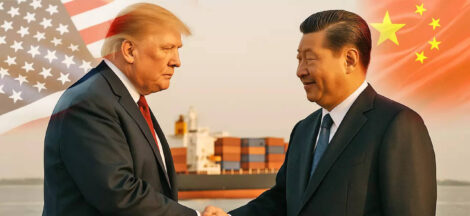By Sanjay Roy
A huge campaign is going on across the country about India aspiring to become a developed country in 2047. There is nothing wrong in targeting something big with the hope that even if it fails, we could still reach somewhere near to what had been the goal. The goal, however, should not be so unrealistic that people think it infeasible to begin with. India is currently the fastest growing economy in the world and there is a possibility of maintaining the relatively high growth in the coming years compared to global average.
But growth is an indicative metric which is a result of several complex processes that influence the outcome of value addition. It is not only good wishes and missions that determine economic growth. Particularly in a globalised world where there are several factors which influence economic outcomes including trade environment, investment flows, impact of technology, productivity and frontiers of technologies in different segments, migration, climate change and most importantly engagement of economic actors at various levels and policies which are influenced by political factors.
Economic textbooks simplify this complex world by building a narrative where economic relations appear to be sanitised from political, cultural and ideological factors and tend to hide the underlying power relations that operate at various levels. Aspirations materialise on the basis of how policymakers drive policies incentivising actions that are in sync with defined goals. If we have goals to achieve a particular growth rate, then we need to identify our strengths and gaps. Markets are good in picking winners but not so good in signalling resources where there might not be immediate gains.
Economic policies and development models of the Washington Consensus and also of post-Washington Consensus are largely devoted to assigning the market the prime role in distribution of resources. Intervention of the State is subject to the outcomes of the market. In other words, the underlying principles of these versions of neoliberal model is that the market should be given free hand but the losers in the process may at best be provided some handholding to sail across.
According to the World Development Indicators, India’s per capita income in 2023 is $2,540 which is categorised as a low-middle income by the World Bank, ranking in the per capita income bracket of $1,136 to $ 4,465. Developed countries are those recording a per capita income above $13,846. China’s per capita income in 2023 was $13,390, approaching the per capita income level of developed countries.
Advanced economies such as the United Kingdom record per capita income levels much higher than $47,700 and the USA $80,450. To achieve per capita income of $13,846 by 2047 requires a per capita income growth of 8 percent per annum which is simply the compound annual growth rate required for the next 22 years from 2025 on to reach the minimum threshold of a developed country’s per capita income. The highest achieved per capita income growth in India in the past 50 years were recorded in two episodes, 2003-07 and 2014-18 and the average growth of per capita income turned out to be 6.1 percent.
The annual growth rate of per capita income crossed 8 per cent only in one year in the past 50 years and that was in 2021. This happened because of the low base experienced during the pandemic as the growth rate of per capita income in the preceding year 2020 was (-)7.1 percent. Therefore, achieving 8 percent growth rate in per capita income for every year in the coming 22 years is not something that appears feasible.
Also, these were the periods when India recorded high growth in GDP with close to 8 percent in 2003-07 and average growth of GDP of 7.3 percent during 2014-18. The world economy grew faster in these years, recording average growths of 4 percent and 3 percent respectively in the two episodes. To reach the threshold of upper middle-income countries, which begins at per capita income of $4,446 dollars, an average growth in per capita income of 5.8 percent is required every year for ten years in succession, which is feasible. To reach China’s per capita income of 2023, India would require another 22 years with 8 percent growth in per capita income every year, to reach China’s current per capita income in 2047.
India has certain advantages and disadvantages in achieving perpetual high growth rate in per capita income in the coming years. Its biggest advantage is the ‘demographic dividend’ which of course can’t be realised automatically. Lack of gainful employment in general and high youth and educated unemployment are the real challenges to achieve high growth in per capita income. There has been a sharp rise in inequality in India which influences consumption patterns and the sources of growth. More and more growth is dependent on profit incomes, it reduces the base of economic growth with few earning huge gains through asset inflation while a vast majority remains stuck at the subsistence levels.
High inequality itself becomes a hindrance for desirable growth in per capita income. More importantly, we are on the verge of technological transformation and the new bout of innovation is likely to reduce the use of direct human labour in the production process. According to the Economic Survey, India has to create additional 7.85 million jobs in the non-farm sector every year until 2030.
Growth is not only about producing but also of creating buyers who would be realising the produced values, and that requires strategic intervention on the part of the government creating adequate gainful employment to take advantage of the demographic profile where the dependent population will continue to be lower in proportion for at least another one and half decades.
The global growth scenario has not been encouraging in the recent past and forecasts for the future by the international agencies also do not seem to be high. In the past five years, the world average growth rate was 2.4 percent and, according to the World Economic Outlook and Global Economic Prospects, the projected growth rate for the years 2025-26 are 3.3 percent and 2.7 percent respectively.
These are in any case lower than the average growth of world GDP in the first two decades of the new millennium. Therefore, India has to grow in the midst of slowing down of the global economy although in the past she grew fastest when global growth was high.
It is also important to acknowledge the fact that future industrialisation and growth must happen with net zero emissions. Low carbon footprint in the production structure must be ensured by introduction of green technologies which would be creating unavoidable constraints at least in the short run as the cost of production is expected to increase. Global Economic Prospects highlight the possibilities of rising geopolitical conflicts in the future with countries increasingly being driven by protectionism and trade war. Global trade growth has declined, and the supply chains are likely to be affected by these tensions and conflicts.
Importantly, as the gap between frontier technology and different production structures are declining, the growth of productivity is also showing a declining trend across sectors. Also, climate shocks have disruptive effects on production processes, and all these add to rising uncertainty in the global economy. India cannot be insulated from these global factors but at the same time, countries of the Global South particularly India, and China would be experiencing faster growth in the coming years. The real question is how we strategise to get the best out of our potentials rather than floating slogans that are impossible to achieve. (IPA Service)




 Women’s Employment Will Take 200 Years To Attain Gender Equality
Women’s Employment Will Take 200 Years To Attain Gender Equality 